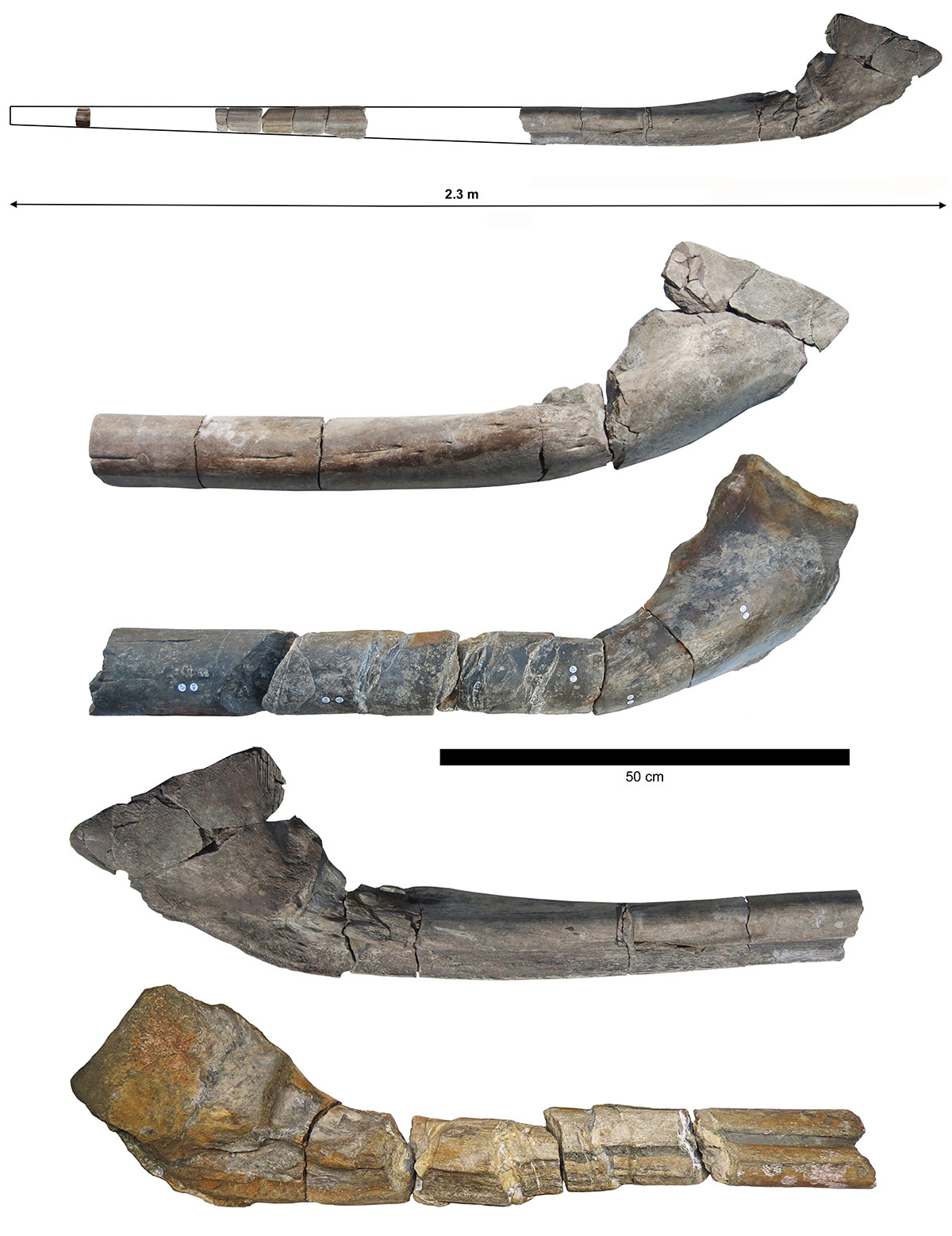Paleontologists already know that the extinct marine reptile ichthyosaurs were enormous. Some newly described jawbone fossils uncovered in England represent a new ichthyosaur species. The bones indicate that the ocean titan may have been over 82 feet long, and even pushed the possible limits of vertebrate size. The new find is detailed in a study published April 17 in the open-access journal PLOS ONE.
“This research has been ongoing for almost eight years. It is quite remarkable to think that gigantic, blue whale-sized ichthyosaurs were swimming in the oceans around what was the UK during the Triassic Period,” study co-author and University of Manchester paleontologist Dean Lomax said in a statement. “These jawbones provide tantalizing evidence that perhaps one day a complete skull or skeleton of one of these giants might be found. You never know.”
Meet the ichthyosaurs
Ichthyosaurs are an extinct group of reptiles that are distant relatives of today’s lizards and snakes. They had long fins and were potentially ambush predators like today’s great white sharks and wolves, feeding on fish and other marine dwellers. Ichthyosaurs also may have followed migration patterns that are similar to today’s whales.
[Related: These ancient, swimming reptiles may have been the biggest animals of all time.]
They lived 228 to 112 million years ago and they were most abundant during the Triassic and Jurassic eras. There are over 100 known ichthyosaur species. Their remains have been found in parts of Asia, North America, and Europe. A fossil deposit in present day Nevada may have even been an ichthyosaur birthing ground.
Solving a prehistoric jigsaw puzzle
Over several years, a team from The University of Manchester has discovered and pieced together individual fragments of an ichthyosaur jawbone. A jawbone uncovered in 2016 at the Westbury Mudstone Formation in Somerset was similar to one collected from the same rock formation just a few miles away. The team believe that both of these jawbones belong to a previously undescribed species of ichthyosaur.
In 2020, a father and daughter from Devon named Justin and Ruby Reynolds found the first pieces of the second jawbone to be found in May 2020. Ruby was 11 years-old at the time and found the first chunk of giant bone before searching for more pieces. The family contacted Lomax and fossil collector and study co-author Paul de la Salle, who found the first jawbone in 2016.
 The nearly complete giant jawbone, along with a comparison with the 2018 bone (middle and bottom) found by Paul de la Salle. CREDIT: Dean Lomax
The nearly complete giant jawbone, along with a comparison with the 2018 bone (middle and bottom) found by Paul de la Salle. CREDIT: Dean Lomax “I was amazed by the find. In 2018, my team studied and described Paul’s giant jawbone and we had hoped that one day another would come to light,” said Lomax. “This new specimen is more complete, better preserved, and shows that we now have two of these giant bones–called a surangular–that have a unique shape and structure. I became very excited, to say the least.”
Over time, several members of the Reynolds family, Paul, and Lomax’s research team visited the site to hunt for more pieces of this rare discovery. They found more pieces of the same jaw which happened to fit together perfectly.
[Related: Why kids make the best amateur fossil hunters.]
“It was so cool to discover part of this gigantic ichthyosaur. I am very proud to have played a part in a scientific discovery like this,” Ruby Reynolds said in a statement. Ruby and her father are both listed as co-authors of the new study.
A new ichthyosaur species
The final piece of bone was recovered in October 2022. The research team found that the jaw bones belong to a new species of giant ichthyosaur they named Ichthyotitan severnensis, or “giant fish lizard of the Severn.” It was likely the size of the blue whale–today’s largest living organism. Comparing the two examples of the same bone with the same unique features from the same geologic time zone helps support the idea that it is a new species.
 An illustration showing a pair of swimming Ichthyotitan severnensis’. CREDIT: Gabriel Ugueto/ Gabriel Ugueto
An illustration showing a pair of swimming Ichthyotitan severnensis’. CREDIT: Gabriel Ugueto/ Gabriel Ugueto The bones are about 202 million years old and date back to the end of the Triassic Period called the Rhaetian. During the Rhaetian, gigantic ichthyosaurs swam while dinosaurs walked on land. However, this was when ichthyosaurs’ time on Earth came to a close. They went extinct during the Late Triassic global mass extinction event some 200 million years ago and these bones represent the very last of their kind. Dinosaurs would not go on to live another 134 million years.
While this new discovery is not the first giant ichthyosaur, these findings are unique among those known to science. These two bones appear about 13 million years after their latest geologic relatives. These include Shonisaurus sikanniensis from British Columbia, Canada, and Himalayasaurus tibetensis from Tibet, China. A closer examination of the bones’ internal structures also confirmed that the animal was likely still growing at its time of death.
“The anomalous periosteal growth of these bones hints at yet to be understood bone developmental strategies, now lost in the deep time, that likely allowed late Triassic ichthyosaurs to reach the known biological limits of vertebrates in terms of size,” Marcello Perillo, a study co-author and a paleobiology master’s student at the University of Bonn in Germany, said in a statement. “So much about these giants is still shrouded by mystery, but one fossil at a time we will be able to unravel their secret.”
The ichthyosaur bones will soon be on display at the Bristol Museum and Art Gallery.
















